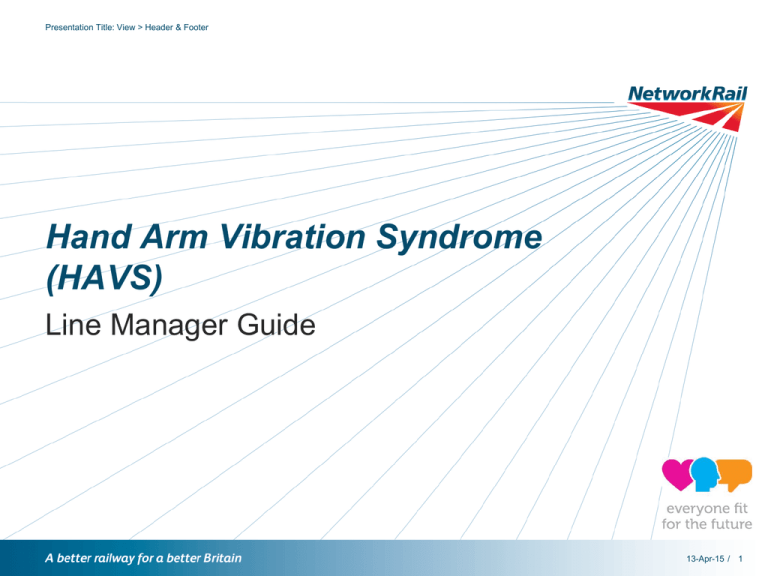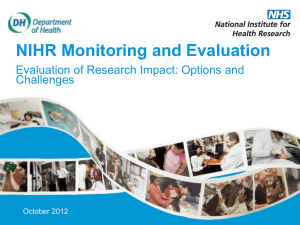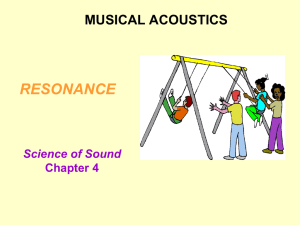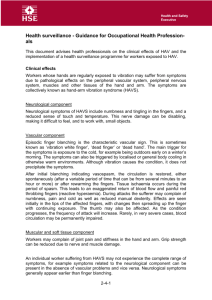Hand Arm Vibration Syndrome (HAVS) - Safety Central
advertisement

Presentation Title: View > Header & Footer Hand Arm Vibration Syndrome (HAVS) Line Manager Guide 13-Apr-15 / 1 Presentation Title: View > Header & Footer What Will Be Covered Health Effects of Exposure to Vibration What is HAVS What is CTS The Law Control Measures Exposure levels explained Small Plant Data sheet Monitoring Exposure Health Surveillance Investigation Further Guidance 13-Apr-15 / 2 Presentation Title: View > Header & Footer Health Effects of Exposure to Vibration Regular and frequent exposure to hand-arm vibration can lead to two health conditions Hand Arm Vibration syndrome (HAVS) and Carpal Tunnel Syndrome (CTS) 13-Apr-15 / 3 Presentation Title: View > Header & Footer What is Hand Arm Vibration Syndrome? HAVS Symptoms and effects of HAVS include tingling and numbness in the fingers which can result in an inability to do fine work (e.g. assembling small components) or everyday tasks (e.g. fastening buttons) loss of strength in the hands which might affect the ability to do work safely the fingers going white (blanching) and becoming red and painful on recovery, reducing ability to work in cold or damp conditions especially outdoors 13-Apr-15 / 4 Presentation Title: View > Header & Footer What is Carpal Tunnel Syndrome? CTS Carpal tunnel syndrome is caused by compression of the nerve that controls sensation and movement in the hands The carpal tunnel is a narrow passage in your wrist made up of small bones and a tough band of tissue. It acts as a pulley for the tendons that bend the fingers Symptoms of CTS include tingling, numbness, pain and weakness in the hand which can interfere with work and everyday tasks 13-Apr-15 / 5 Presentation Title: View > Header & Footer Symptoms of both may come and go, but with continued exposure to vibration they may become permanent and cause pain, distress and sleep disturbance This can happen after only a few months of exposure, but in most cases it will happen over a few years 13-Apr-15 / 6 Presentation Title: View > Header & Footer What the Law Says The Control of Vibration Regulations 2005 say you must Identify and measure exposure to eliminate or reduce risk of exposure to hand arm vibration – risk assessments, tool selection Make sure that the legal limits of exposure to vibration are not exceeded Ensure control measure are properly applied – e.g. job rotation Provide information, instruction and training to employees – briefings Provide suitable health surveillance – and ensure compliance* 13-Apr-15 / 7 Presentation Title: View > Header & Footer Control Measures Elimination – change the way of work so that vibrating tools are no longer used Substitution – replacing tools with ones with lower vibration emission Task Considerations – does the task need to be done manually or can it be mechanised? Task Rotation – within each shift make sure that individuals change the tasks that they do so that they do not breach the exposure levels (EAV or ELV) Monitor Individual’s Vibration Exposure 13-Apr-15 / 8 Presentation Title: View > Header & Footer EAV and ELV explained EAV Exposure Action Value 2.5m/s² A (8) The level at which measures should be introduced to eliminate or control risk to be as low as possible ELV Exposure Limit Value 5m/s² A (8) The level which should not be exceeded and at which immediate action should be taken to reduce vibration exposure The exposure limit value (ELV) is the maximum amount of vibration an employee may be exposed to on any single day 13-Apr-15 / 9 Presentation Title: View > Header & Footer Points System The points system has been devised by the Health and Safety Executive (HSE) to simplify measuring daily exposure to vibration The system converts the vibration (m/s²) into points 100 points per day = exposure action value (EAV) 400 points per day = exposure limit value (ELV) 13-Apr-15 / 10 Presentation Title: View > Header & Footer HAVS Data Sheet Found on Safety Central Contains vibration data on each tool approved for use by Network Rail Details how much trigger time will be needed to reach the EAV or ELV Breaks down the points accumulated into 5 minute blocks for easy calculation 13-Apr-15 / 11 Presentation Title: View > Header & Footer Monitoring Vibration Exposure Exposure to vibration can be measured either by a paper based record completed by the employee or Using technology – an electronic vibration monitoring device It is important to have an understanding of each persons exposure to be able to identify employees at risk and to control the risk 13-Apr-15 / 12 Presentation Title: View > Header & Footer Responsibilities Line Manager – Know which employees are at risk Provide information to employees Ensure control measures are in place Plan tasks to eliminate or reduce exposure Ensure employees take part in health surveillance Investigate when a new or worsening case of HAVS is identified Employee – Know how to spot early signs of HAVS Report any problems to their line manager Take part in health surveillance Make sure control measures are used correctly 13-Apr-15 / 13 Presentation Title: View > Header & Footer Mandatory Health Surveillance The first health surveillance check should be carried out before the employee starts to use vibrating tools – a guide should be to arrange the surveillance before booking training or competency sessions A further health check is needed 6 months after starting to use tools then Every employee exposed to vibration on a regular basis should take part in annual health surveillance 13-Apr-15 / 14 Presentation Title: View > Header & Footer Mandatory Health Surveillance Tier 1 – first stage of health surveillance before using tools using questionnaire Tier 2 – second stage using questionnaire for annual surveillance Tier 3 – a face to face appointment with a nurse carried out every third year or if any concerns are highlighted Tier 4- a face to face appointment with a physician who can give a diagnosis of HAVS 13-Apr-15 / 15 Presentation Title: View > Header & Footer Managing Health Surveillance Know which employees are at risk Update HRSS with names of those employees who are exposed to vibration when requested Monitor compliance by tracking completion of questionnaire and attendance at appointments Carry out health briefings Follow health surveillance guidance within HAVS management standard 13-Apr-15 / 16 Presentation Title: View > Header & Footer Investigation Process The investigation process should always be carried out when new or worsening cases of HAVS are identified as this could mean that the control measures have failed The outcome of every employees HAVS assessment will be available on Oracle Investigations should always include the employee, a trained investigator and a health and safety professional Look at areas such as the individuals vibration exposure, tools used and maintenance schedules, working hours including overtime, task rotation compliance 13-Apr-15 / 17 Presentation Title: View > Header & Footer What to do if an Employee has HAVS The fit slip from OH will advise on any restrictions on working – Always follow advice from Occupational Health Reduce/restrict vibration exposure as directed Spend time with the employee outlining any restrictions Ensure that employee complies with subsequent health surveillance Encourage the employee to report any further concerns they may have 13-Apr-15 / 18 Presentation Title: View > Header & Footer Need Help? Presentations, Factsheets and Briefings on Health Portal People who can help - safety representatives, trade union reps, occupational health provider, HRSS, occupational specialists and managers HAVS standard and guidance documents on Connect 13-Apr-15 / 19 Presentation Title: View > Header & Footer Questions? 13-Apr-15 / 20











